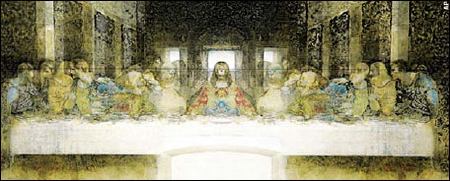Wormburgers —
An article in the Japanese
Mainichi Daily News (which claims to be merely repeating a story that appeared in a magazine called Fushigi Knuckles) tells the story of the attempt to introduce Wormburgers in Japan. An Aomori Prefecture company, so the story goes, tried to market worms as food for human consumption because of the high nutritional value of worms:
Instead of a beef patty, the Worm Burger used ground worms, cut the onions a little, added wheat flour, a runny egg and blended in milk to make it go down easier. The magazine notes that despite the best intentions, the Worm Burger ended up as a major flop. Marketers had been targeting women and young people, but appear to have struggled to overcome worms' image as a bizarre food.
Maybe this really happened, but probably not. It's more likely that this is a recycling of the old Wormburger urban legend from the late 1970s. This urban legend got launched when papers reported that food scientists were experimenting with earthworms as a source of protein. Take, for instance, this UPI article that appeared in a number of American newspapers in mid-December, 1975:
EARTHWORMS MAY BE NEW FOOD SOURCE
Sacramento, Calif. (UPI)
You may one day be eating earthworm casserole. And redworm cookies.
The lowly earthworm, ignored by almost everybody but the fisherman, is burrowing its way into the world of big business, and may be put to work soon to help man grow crops, dispose of garbage and even satisfy his dietary need for protein.
So says Frank Carmody, market development director for North American Bait Farms of Ontario, Calif., one of the nation's largest growing and marketing businesses ...
If produced in sufficient quantity at a cost competitive with other protein materials, he said, worms could be used as feed for pets, poultry, fish and other animals as well as food for people. Seventy-two per cent of a worm's dry weight is protein.
Sponsor of a worm recipe contest, North American Bait has received ideas for adding dried, crispy worms to salads, casseroles and cookies. Carmody says redworm cookies are "delicious."
After a few articles like this appeared, it was simply a matter of time before tales began to spread of McDonalds and other fast-food chains secretly using worms in their burgers. However, worms are in no way cost competitive with other sources of protein such as beef. So there's little reason to fear that fast-food chains will start padding their burgers with worms any time soon.

 Kevin Keeble stirred up a lot of excitement when he sent pictures to the Newquay Guardian showing a great white shark that he claimed to have spotted about a mile off the coast of Cornwall. At the time he said, "We were out about one mile off Towan Head and I saw this fin in the distance. We were reeling in the mackerel but I picked up my camera and caught a picture with my telephoto lens. The shark was about 100ft away. It was only there for a few seconds before it disappeared."
Kevin Keeble stirred up a lot of excitement when he sent pictures to the Newquay Guardian showing a great white shark that he claimed to have spotted about a mile off the coast of Cornwall. At the time he said, "We were out about one mile off Towan Head and I saw this fin in the distance. We were reeling in the mackerel but I picked up my camera and caught a picture with my telephoto lens. The shark was about 100ft away. It was only there for a few seconds before it disappeared."  C.P. Smith, an editor at the Orange County Register, has accepted a buyout and will soon be leaving his job. And during his final days at work he's decided to become a prankster. After all, what can management do? Fire him?
C.P. Smith, an editor at the Orange County Register, has accepted a buyout and will soon be leaving his job. And during his final days at work he's decided to become a prankster. After all, what can management do? Fire him? I got an email from my wife with a link to a JL421 Badonkadonk Land Cruiser/Tank being sold on Amazon. She had a single question: Is this real?
I got an email from my wife with a link to a JL421 Badonkadonk Land Cruiser/Tank being sold on Amazon. She had a single question: Is this real?
 Mike Wood of West Salem, Ohio has figured out an ingenious way to slow traffic in his neighborhood. He makes life-size cardboard cutouts of his children. Then he places the cutouts along the side of the road. People driving by think there's a real kid standing by the side of the road and they slow down.
Mike Wood of West Salem, Ohio has figured out an ingenious way to slow traffic in his neighborhood. He makes life-size cardboard cutouts of his children. Then he places the cutouts along the side of the road. People driving by think there's a real kid standing by the side of the road and they slow down.  Here's yet another image of Jesus on a tree to add to my collection.
Here's yet another image of Jesus on a tree to add to my collection. 





 This has nothing to do with hoaxes, but I thought it was interesting, so I'm posting about it anyway. Also, it reminded me of the Compliment Machine, which I posted about just a few days ago.
This has nothing to do with hoaxes, but I thought it was interesting, so I'm posting about it anyway. Also, it reminded me of the Compliment Machine, which I posted about just a few days ago.
 Lots of blogs have been posting this recent Intel ad, pointing out the racist implications of six black men appearing to bow down to a white man. (I actually think all the crouching runners are the same guy, photoshopped into six different places.)
Lots of blogs have been posting this recent Intel ad, pointing out the racist implications of six black men appearing to bow down to a white man. (I actually think all the crouching runners are the same guy, photoshopped into six different places.)  FlexPetz is a San Diego-based company that allows people to rent out dogs by the day. So if you want to be able to take a dog to the beach on the weekend, but you don't have time to care for it during the week, this is the service for you. Marlena Cervantes, the founder of the company, doesn't like the term "rent-a-pet," according to this AP article. Instead, she likes to think of what she's offering as "shared pet ownership." The service is quite pricey, but it's doubtless cheaper than caring for a dog yourself for its entire life.
FlexPetz is a San Diego-based company that allows people to rent out dogs by the day. So if you want to be able to take a dog to the beach on the weekend, but you don't have time to care for it during the week, this is the service for you. Marlena Cervantes, the founder of the company, doesn't like the term "rent-a-pet," according to this AP article. Instead, she likes to think of what she's offering as "shared pet ownership." The service is quite pricey, but it's doubtless cheaper than caring for a dog yourself for its entire life.